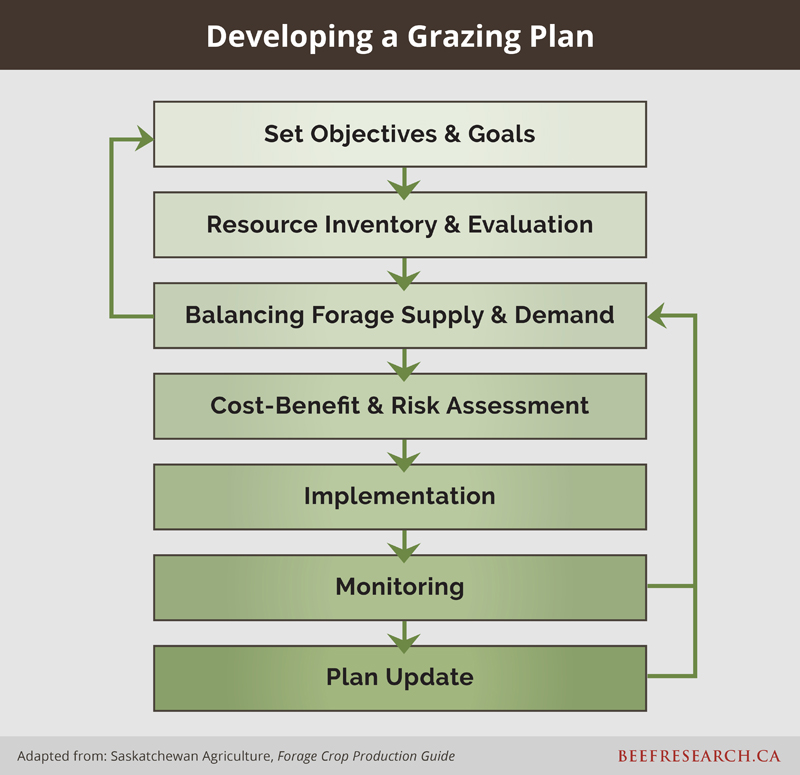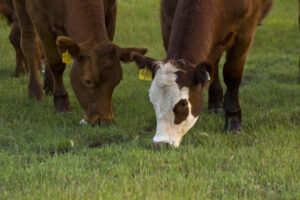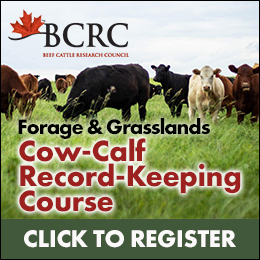Developing a Grazing Plan: Make the Most of the Forage You Have Available
Developing a grazing plan is an important first step to ensure effective grazing management on an operation, and it can help save a producer on their cost of production in the long run.
A grazing plan that matches animal numbers to predicted forage yields is something that should be done prior to animal turn out. Within a grazing plan there are several key steps that should be included. These include setting objectives and goals, resource inventory and evaluation, balancing forage supply and demand, cost-benefit and risk assessment, implementation, monitoring, and finally, the plan update.

Setting Goals and Objectives
A key step in developing a grazing plan is defining the goals and objectives for the entire grazing operation. This includes lifestyle choices such as how much time a producer may want to spend moving their livestock around each week, profitability measures and biological outcomes such as forage production, soil health, animal performance and ecosystem impacts.
Resource Inventory & Evaluation
Completing an inventory and evaluating resources is crucial for developing and implementing a successful grazing system. This resource inventory can answer questions such as:
- How much forage is available and at what times of the grazing season?
- Is the forage source able to meet the animals required nutritional requirements?
- How long is the intended grazing season?
- What physical infrastructure is available or needed?

Balancing Forage Supply & Demand
Ensuring that the forage supply and demand is balanced is a critical step when developing a grazing plan. Whether managing native rangeland or a tame forage species, it is important that these four basic principles of management are applied:
- the number of animals is balanced with the forage supply,
- there is a uniform distribution of animals over the landscape,
- periods of grazing and rest are alternated to maintain the vegetation and
- the kind of livestock that are most suited to that forage and management are used.
How the forage supply and demand are balanced all ties back to the goals and objectives for the grazing management of that operation.
Cost-Benefit & Risk Assessment
The cost-benefit and risk assessment is the next step in developing a grazing plan. Effective grazing management on a pasture ensures high forage yield, sustainability and animal health and productivity, all of which impact the cost of production. Completing a risk assessment in addition to looking at the cost-benefits can help an operation improve its grazing management plan.
Implementation
Implementation is the next stage in developing a grazing plan. There are several different grazing systems a producer may choose to implement due to variance in climate, plant species, soil and livestock. These different grazing systems include but are not limited to: rotational grazing, forward grazing, creep grazing, limit grazing, stockpile grazing and extended grazing.
Monitoring
After the grazing plan has been implemented, it is important to ensure the pasture is monitored to make sure the objectives and goals that the producer set up at the beginning of their grazing plan are met. Keeping accurate and up-to-date pasture records is vital to inform future grazing plans by providing information such as an accurate assessment of the carrying capacity of a pasture.
Plan Update
After monitoring the pasture, if the current plan did not meet the goals and objectives, it is important to consider updating the grazing plan to better aim for these goals next season. Grazing plans should be flexible to accommodate changing conditions such as fluctuations in livestock numbers or drastic swings in precipitation.

LEARN MORE
- Grazing Management (BCRC webpage)
- Managing and Planning Grazing (BCRC webpage)
- BCRC Carrying Capacity Calculator (decision tool)
Click here to subscribe to the BCRC Blog and receive email notifications when new content is posted.
The sharing or reprinting of BCRC Blog articles is welcome and encouraged. Please provide acknowledgement to the Beef Cattle Research Council, list the website address, www.BeefResearch.ca, and let us know you chose to share the article by emailing us at info@beefresearch.ca.
We welcome your questions, comments and suggestions. Contact us directly or generate public discussion by posting your thoughts below.